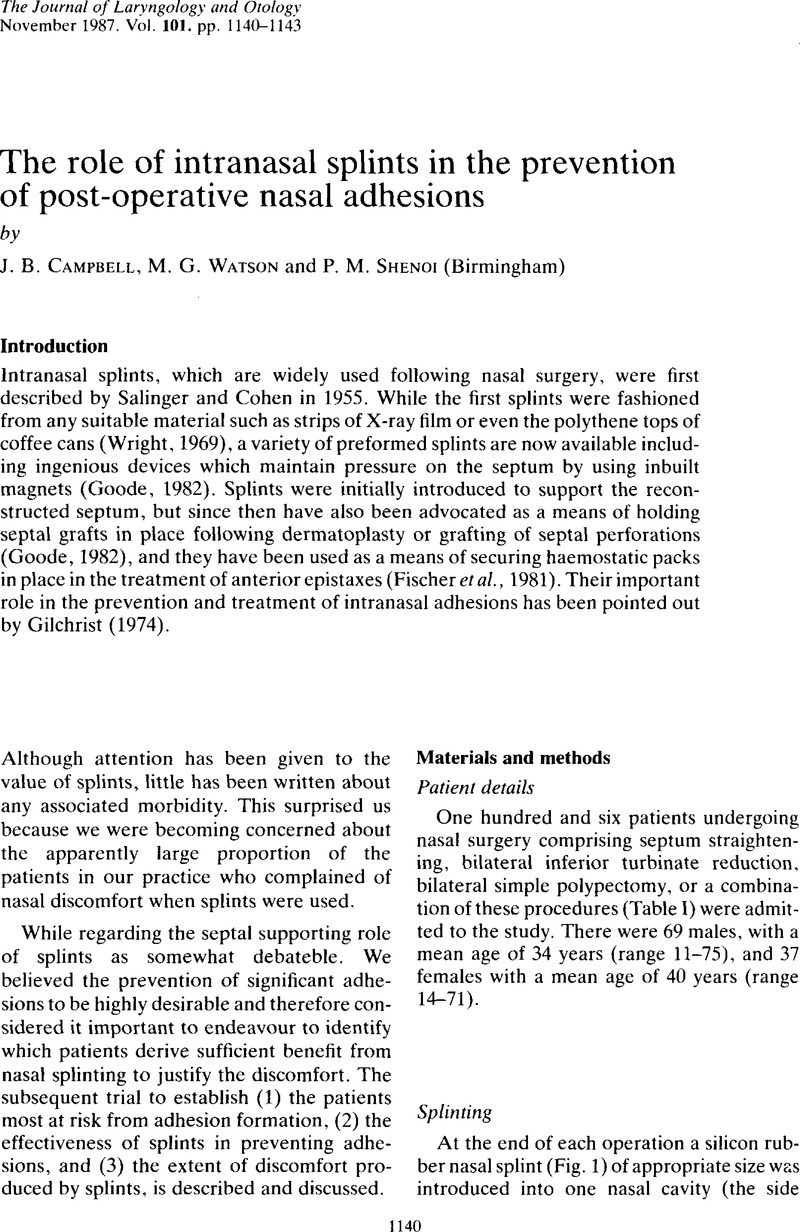Crossref Citations
This article has been cited by the following publications. This list is generated based on data provided by Crossref.
Eliopoulos, P. N.
and
Philippakis, C.
1989.
Prevention of post-operative intra-nasal adhesions.
The Journal of Laryngology & Otology,
Vol. 103,
Issue. 7,
p.
664.
Evans, P. H. Rhys
1989.
Complications in head and neck surgery and how to avoid trouble.
The Journal of Laryngology & Otology,
Vol. 103,
Issue. 10,
p.
926.
Campbell, J. B.
Morgan, D. W.
Snow, D. G.
and
Simons, R. M.
1990.
Total Inferior Turbinectomy: Benefits and Complications.
American Journal of Rhinology,
Vol. 4,
Issue. 2,
p.
57.
Watson, M. G.
and
Marshall, H. F.
1990.
Intranasal adhesions which recur despite splinting: an ominous sign?.
The Journal of Laryngology & Otology,
Vol. 104,
Issue. 5,
p.
426.
PRINGLE, M. B.
1992.
The use of intra-nasal splints: a consultant survey.
Clinical Otolaryngology,
Vol. 17,
Issue. 6,
p.
535.
SCHOENBERG, MARCELLE VON
ROBINSON, PHILIP
and
RYAN, ROWENA
1992.
The morbidity from nasal splints in 105 patients.
Clinical Otolaryngology,
Vol. 17,
Issue. 6,
p.
528.
COOK, JAMES A.
MURRANT, NICHOLAS J.
EVANS, KATE L.
and
LAVELLE, RICHARD J.
1992.
Intranasal splints and their effects on intranasal adhesions and septal stability.
Clinical Otolaryngology,
Vol. 17,
Issue. 1,
p.
24.
Guyuron, Bahman
and
Vaughan, Carol
1995.
Evaluation of stents following septoplasty.
Aesthetic Plastic Surgery,
Vol. 19,
Issue. 1,
p.
75.
Malki, D.
Quine, S. M.
and
Pfleiderer, A. G.
1999.
Nasal splints, revisited.
The Journal of Laryngology & Otology,
Vol. 113,
Issue. 8,
p.
725.
Nunez, D A.
and
Bradley, P J.
2000.
A randomised clinical trial of turbinectomy for compensatory turbinate hypertrophy in patients with anterior septal deviations.
Clinical Otolaryngology and Allied Sciences,
Vol. 25,
Issue. 6,
p.
495.
Mantovani, Mario
Guastella, Claudio
and
Mazzola, Riccardo F.
2000.
The Guastella/Mantovani Septal-Valve Splint: An Intranasal Biplanar and Multivectorial Orthopedic Device.
Plastic & Reconstructive Surgery,
Vol. 106,
Issue. 2,
p.
475.
Piatti, G.
Scotti, A.
and
Ambrosetti, U.
2004.
Nasal Ciliary Beat After Insertion of Septo‐Valvular Splints.
Otolaryngology–Head and Neck Surgery,
Vol. 130,
Issue. 5,
p.
558.
Boccieri, Armando
Pascali, Michele
and
Macro, Carlo
2005.
The atraumatic septorhinoplasty.
European Journal of Plastic Surgery,
Vol. 28,
Issue. 5,
p.
343.
Dubin, Marika R.
and
Pletcher, Steven D.
2009.
Postoperative Packing After Septoplasty: Is It Necessary?.
Otolaryngologic Clinics of North America,
Vol. 42,
Issue. 2,
p.
279.
Jung, Yong Gi
Hong, Ji Won
Eun, Young-Gyu
and
Kim, Myung-Gu
2011.
Objective Usefulness of Thin Silastic Septal Splints after Septal Surgery.
American Journal of Rhinology & Allergy,
Vol. 25,
Issue. 3,
p.
182.
Asaka, Daiya
Yoshikawa, Mamoru
Okushi, Tetsushi
Nakayama, Tsuguhisa
Matsuwaki, Yoshinori
Otori, Nobuyoshi
and
Moriyama, Hiroshi
2012.
Nasal splinting using silicone plates without gauze packing following septoplasty combined with inferior turbinate surgery.
Auris Nasus Larynx,
Vol. 39,
Issue. 1,
p.
53.
Dag, Ilknur
Acar, Mustafa
Sakallioglu, Oner
Catli, Tolgahan
San, Turhan
and
Cingi, Cemal
2014.
Influence of surface properties of Merocel® (polyvinyl acetal) and silicone nasal splints on biofilm formation.
European Archives of Oto-Rhino-Laryngology,
Vol. 271,
Issue. 6,
p.
1519.
Mantovani, Mario
Rinaldi, Vittorio
Torretta, Sara
Sigismund, Paolo Enrico
Cappadona, Maurizio
Minetti, Andrea
and
Pignataro, Lorenzo
2014.
The Dragonfly Splint.
Journal of Craniofacial Surgery,
Vol. 25,
Issue. 2,
p.
547.
LoSavio, Phillip S.
and
O’Toole, Thomas R.
2015.
Practical Medical and Surgical Management of Chronic Rhinosinusitis.
p.
483.
San, Turhan
Ertugay, Omer Cagatay
Catli, Tolgahan
Acar, Mustafa
Ertugay, Cigdem Kalaycik
Dag, Ilknur
and
Cingi, Cemal
2015.
Effects of surfactant on biofilm formation on silicone nasal splints.
European Archives of Oto-Rhino-Laryngology,
Vol. 272,
Issue. 2,
p.
345.



